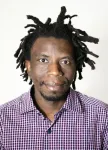(Press-News.org) Whether wastewater is full of "waste" is a matter of perspective.
"Why is it waste?" asked Zhen (Jason) He, professor in the Department of Energy, Environmental & Chemical Engineering in the McKelvey School of Engineering at Washington University in St. Louis.
"It's organic materials," He said, and those can provide energy in a number of ways. Then there's the other valuable resource in wastewater.
Water.
He's lab has developed one system that recovers both, filtering wastewater while creating electricity. Results from bench-scale trials were published May 6 and featured as a front cover article in the journal Environmental Science: Water Research & Technology.
The waste materials in wastewater are full of organic materials which, to bacteria, are food.
"Bacteria love them and can convert them into things we can use," He said. "Biogas is the primary source of energy we can recover from wastewater; the other is bioelectricity."
There already exist ways to capitalize on bacteria to produce energy from wastewater, but such methods often do so at the expense of the water, which could be filtered and otherwise be used -- if not for drinking -- for "grey water" purposes such as irrigation and toilet flushing.
He's lab took the two processes -- filtration and energy production -- and combined them, integrating the filtration system into the anode electrode of a microbial electrochemical system.
The system is set up like a typical microbial fuel cell, a bacterial battery that uses electrochemically active bacteria as a catalyst where a traditional fuel cell would use platinum. In this type of system, the bacteria are attached to the electrode. When wastewater is pumped into the anode, the bacteria "eat" the organic materials and release electrons, creating electricity.
To filter that same water, however, requires a different system.
He's lab combined the systems, developing a permeable anode that acts as a filter.
The anode is a dynamic membrane, made of conductive, carbon cloth. Together, the bacteria and membrane filter out 80% to 90% of organic materials -- that leaves water clean enough to be released into nature or further treated for non-potable water uses.
He used a mixed culture of bacteria, but they had to share one feature -- the bacteria had to be able to survive in a zero-oxygen environment.
"If there was oxygen, bacteria would just dump electrons to the oxygen not the electrode," He said. "If you cannot respire with the electrode, you'll perish."
To find the correct bacteria, He mostly defers to nature.
"It's not 100 percent natural, but we select those that can survive in this condition," He said. "It's more like 'engineered selection,'" the bacteria that did survive and respire with the electrode were selected for the system.
The amount of electricity created is not enough to, say, power a city, but it is in theory enough to help to offset the substantial amount of energy used in a typical U.S. water treatment plant.
"In the U.S., about 3% to 5% of electricity is used for water and wastewater activity," He said. Considering the usage by a local municipal plant, He believes his system can reduce energy consumption significantly.
"Typically, the process consumes about 0.5 KWH of electricity per cubic meter," He said. Based on bench scale experiments, "We can reduce it by half, or more of that."
But the primary goal of He's system isn't electricity production, it's wastewater treatment and nutrient recovery.
"Bacteria can convert those organic materials into things we can use," He said. "We can also recover nutrients like nitrogen or phosphorus for fertilizer. We can use it to feed plants. It's only when we don't use it, then it becomes waste.
"Wastewater is a resource in the wrong location."
INFORMATION:
As humans, the weather where we live influences our energy consumption. In climates where weather shifts from hot summers to very cold winters, humans consume more energy since the body has to work harder to maintain temperature.
In much the same way, weather influences microbes such as bacteria and fungi in the soil. Seasonal fluctuations in soil temperature and moisture impact microbial activities that in turn impact soil carbon emissions and nutrient cycles.
Microbes consume carbon as the source of energy. As microbes increase in quantity and activities, they consume more carbon which results in more carbon emissions and vice versa.
In a modeling study published in Global Change Biology on May 10, San Diego State University ...
DALLAS, May 10, 2021-- Hospitalized COVID-19 patients with impaired first-phase ejection fraction were nearly 5 times more likely to die compared to patients with healthier measures of this early, often undetected sign of heart failure, according to new research published today in Hypertension, an American Heart Association journal. First-phase ejection fraction is a measure of the left ventricular ejection fraction until the time of maximal ventricular contraction.
Cardiovascular risk factors and/or disease have been recognized as COVID-19 risk factors that have a high negative impact on patient outcomes, since early in the SARS-CoV-2 pandemic. Researchers ...
DALLAS, May 10, 2021 — Managing weight, blood pressure and cholesterol in children may help protect brain function in later life, according to new research published today in the American Heart Association’s flagship journal Circulation. This is the first study to highlight that cardiovascular risk factors accumulated from childhood through mid-life may influence poor cognitive performance at midlife.
Previous research has indicated that nearly 1 in 5 people older than 60 have at least mild loss of brain function. Cognitive deficits are known to be linked with cardiovascular risk factors, ...
DALLAS, May 10, 2021 — In a small study, researchers found college athletes who contracted COVID-19 rarely had cardiac complications. Most had mild COVID symptoms that did not require treatment, and in a small percentage of those with abnormal cardiac testing, there was no evidence of heart damage on special imaging tests. All athletes returned to sports without any health concerns, according to new research published today in the American Heart Association’s flagship journal Circulation.
In spring 2020, concerns about heart damage, especially inflammation, among athletes with COVID-19 led to recommendations for cardiac screening based on symptom severity before resuming training and competition. The preferred diagnostic test for heart inflammation is an MRI of the heart, ...
Low levels of serotonin in the brain are seen as a possible cause of depression and many antidepressants act by blocking a protein that transports serotonin away from the nerve cells. A brain imaging study at Karolinska Institutet now shows that the average level of the serotonin transporter increased in a group of 17 individuals who recovered from depression after cognitive behavioural therapy. The results are published in the journal Translational Psychiatry.
"Our results suggest that changes to the serotonin system are part of the biology of depression and that this change is related to the episode rather than a static feature - a state rather than a trait," says the study's last author Johan Lundberg, researcher at the Department of Clinical Neuroscience, ...
What has fluid physics to do with the spreading of the Corona virus? Whirlpools and pandemics seem to be rather different things, certainly in terms of comfort. Yet, newest findings about epidemic spreading come from Physics professor Björn Hof and his research group at the Institute of Science and Technology Austria (IST Austria), who specialize in fluids and turbulent flows. When early last year Björn Hof had to cancel his scheduled visit to Wuhan, his wife's hometown, his focus abruptly shifted to epidemic spreading.
"My group normally investigates turbulent flows in pipes and channels", he explains, "Over the last 10 years we have shown that the onset of turbulence is described ...
Infertility affects females and males equally. In male infertility, azoospermia (a medical condition with no sperm in semen) is a major problem that prevents a couple from having a child. For the treatment of patients with azoospermia, testicular sperm extraction (TESE) is required to obtain mature sperms. When examined, histological specimens are typically given a score, called the Johnsen score, on a scale of 1 to 10, based on the histopathological features of the testis.
"The Johnsen score has been widely used in urology since it was first reported 50 ...
Researchers at Linköping University, Sweden, have made several discoveries on the functioning mechanisms of the inner hair cells of the ear, which convert sounds into nerve signals that are processed in the brain. The results, presented in the scientific journal Nature Communications, challenge the current picture of the anatomical organisation and workings of the hearing organ, which has prevailed for decades. A deeper understanding of how the hair cells are stimulated by sound is important for such matters as the optimisation of hearing aids and cochlear implants for people with hearing loss.
In ...
In 1884, Edwin Abbott wrote the novel Flatland: A Romance in Many Dimensions as a satire of Victorian hierarchy. He imagined a world that existed only in two dimensions, where the beings are 2D geometric figures. The physics of such a world is somewhat akin to that of modern 2D materials, such as graphene and transition metal dichalcogenides, which include tungsten disulfide (WS2), tungsten diselenide (WSe2), molybdenum disulfide (MoS2) and molybdenum diselenide (MoSe2).
Modern 2D materials consist of single-atom layers, where electrons can move ...
UK landowners and conservationists welcome wider-spread use of Gene Conservation Units (GCUs) to help protect some of the rarest plants and insects, research at the University of York has shown.
In particular the Great Yellow Bumblebee and the Mountain Ringlet Butterfly, which are at risk of further population decline, would benefit from Gene Conservation Units, currently only employed for forest trees and agricultural species or their relatives.
Genetic diversity in these species is essential if they are to adapt to new, and often challenging, environmental conditions. Gene Conservation Units are areas of land managed to allow the recovery of species, and maintain evolutionary processes to enable them to adapt to environmental change.
For tree species, ...





